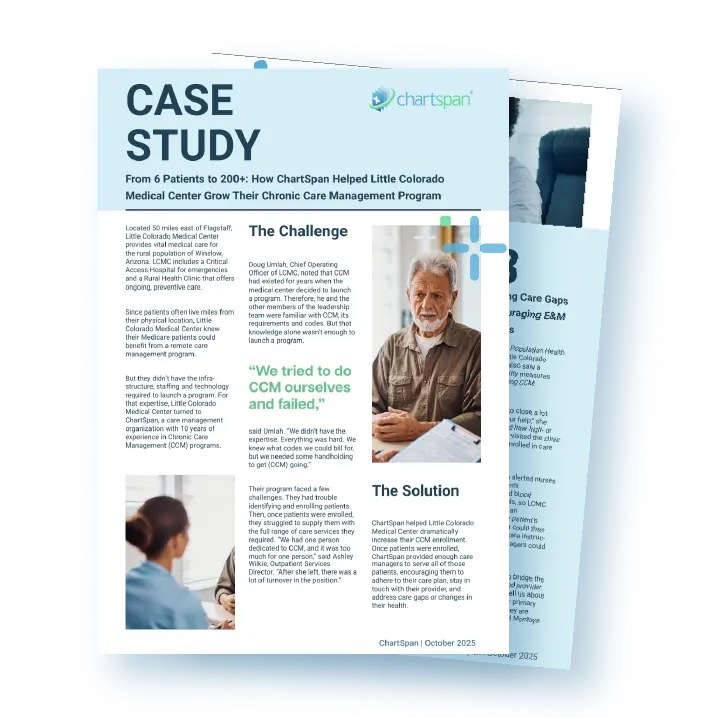
Talk with a ChartSpan Representative Today!
Our team is ready to help you improve patient care and outcomes.
Blog
Preventive Care for Women: How to Overcome Barriers
Chronic conditions are on the rise. For example, more than 27 million Americans live with one or more autoimmune diseases, a type of chronic illness. Nearly 80 percent of this group are women.
Prioritizing timely, preventive care is challenging for many women due to cost, busy schedules, caregiver responsibilities, and complicated appointment scheduling. These barriers can lead to undiagnosed conditions, poor medication adherence, and a reduced quality of life.
Too often, women wait until symptoms appear before seeking medical attention. Preventive care helps providers and patients stay ahead of potential health concerns by increasing touchpoints and encouraging patient participation in their own healthcare. By building strong preventive care programs like Chronic Care Management (CCM) and Advanced Primary Care Management (APCM), providers can proactively support women living with chronic illnesses, such as cardiovascular disease, diabetes, and autoimmune diseases.
ChartSpan can help your practice advocate for women’s preventive care by identifying care gaps and goals, facilitating patient outreach and education, assisting with appointment scheduling and transportation, and providing a 24/7 care line. These services not only strengthen your practice but also make preventive care more accessible for women, paving the way for better engagement, earlier detection, and improved long-term health outcomes.
The importance of preventive care for women
Preventive care is essential for all patients, but women are disproportionately affected by chronic conditions, with nearly four out of five people living with autoimmune diseases being women.
Chronic illnesses that more commonly affect women aren’t limited to female-predominant conditions; women are also more likely to develop chronic conditions that affect both males and females. Without early intervention, these conditions can progress silently, leading to complications that could have been mitigated with routine screenings, early detection, and proactive management.
As the U.S. population ages, preventive care becomes increasingly important. Women tend to live longer than men, which means they’re more likely to face multiple chronic conditions over their lifetime.
Multimorbidity, living with more than one chronic illness, is not only common among women but can also complicate treatment and increase healthcare costs. By identifying and addressing health risks early, preventive care helps women maintain better health and avoid more serious complications later in life.
Additionally, women often take on caregiver roles for family members, which gives them a unique influence on the broader reach of care management. When women are equipped with the right tools, education, and support, they can more effectively manage their own health while extending the benefits of care management to their families.
Preventive care programs that focus on education, regular screenings, and accessible resources empower women to make informed health decisions, prioritize adherence to care plans, and ultimately improve outcomes for themselves and their loved ones.
Timeline of recommended screenings for women
Preventive screenings are a cornerstone of women’s health, helping detect conditions early, when they are often easier to manage. As women age, their risk for certain health issues increases, making it all the more important to stay on top of recommended screenings. The chart below summarizes the recommended preventive screenings* for women at different ages:
| Age | Condition | Screening method |
| 18+ | Depression | Annual evaluation (can be included in AWVs) |
| 18+ | Hypertension | Annual screening (can be included in AWVs) |
| 18+ | Urinary incontinence | Annual screenings (for women 65+, this is a MIPS clinical quality measure that providers can choose to report) |
| 21–65 | Cervical cancer | Pap tests every 3 years from 21 to 29 and every 5 years from 30 to 65 |
| 35–70 | Diabetes | Screening every 3 years for overweight or obese women |
| 40–75 | Breast cancer | Annual or biennial mammogram starting between 40–50, depending on risk |
| 45–75 | Colorectal cancer | Regular colonoscopy, sigmoidoscopy, stool test, or CT colonography; frequency depends on method |
| 50+ | Lung cancer | Annual low-dose CT scan for those with significant smoking history |
| 65+ | Osteoporosis | DEXA scan starting at 65, or sooner for women with risk factors, with follow-up as recommended |
*These are general recommendations; always refer to your provider for specific recommendations.
All of these screenings are covered by Medicare, and thanks to the Affordable Care Act (ACA), most private health insurers also cover recommended screenings without cost sharing. Although most screenings are covered, many patients don’t realize they can get them at no out-of-pocket cost. Providing clear information helps ensure these screenings actually happen.
Annual well-woman visits, recommended by the Women’s Preventive Services Guidelines, often include many of these screenings, including Pap tests and mammograms. However, many women do not schedule these visits regularly. Programs like CCM and APCM can help identify any missed screenings, allowing providers to reach out and help patients stay on track with their preventive care.
Which chronic illnesses and autoimmune diseases are more common in women than men?
Women are disproportionately affected by a range of chronic and autoimmune diseases. While the reasons vary from hormonal changes to genetic differences, understanding which conditions more commonly affect women is key to improving prevention, diagnosis, and management.
- Alzheimer’s disease – About twice as common in women, potentially linked to loss of the X chromosome as women age. Reduced estrogen after menopause may also lessen the brain’s neuroprotective defenses.
- Heart disease – The leading cause of death for women. Risk can be heightened by conditions such as preeclampsia, gestational diabetes, and endometriosis. Smaller blood vessels in women make plaque buildup more likely, and lower estrogen during menopause can raise LDL cholesterol while lowering HDL.
- Depression – More prevalent in women, often connected to hormonal changes during stages like postpartum and perimenopause. Risk of depression is also higher in those with existing chronic conditions.
- Fibromyalgia – Over 80 percent of cases occur in women. Symptoms vary widely, and milder symptoms in men may contribute to underdiagnosis in males.
- Lupus – Nine out of 10 people with lupus are women. Genes that escape X chromosome inactivation have been linked to the condition.
- Multiple sclerosis (MS) – Women are three times more likely to develop MS than men. Though the disease often progresses more slowly in women, hormonal influences are thought to drive the disparity in diagnosis.
- Osteoporosis – About 80 percent of those who have osteoporosis are women. Estrogen decline during perimenopause and menopause accelerates bone resorption, reducing bone density and increasing fracture risk.
- Rheumatoid arthritis (RA) – Women are three times more likely to develop RA, particularly after major hormonal shifts such as pregnancy and menopause. Genetic predisposition also plays a strong role.
- Scleroderma – Four times more common in women than in men. Genes that escape X inactivation can contribute to chronic fibrosis.
- Sjogren’s syndrome – Ten times more common in women. Frequently appears alongside other rheumatic diseases and is diagnosed as a comorbidity in half of cases.
Learn more: The Most Common Chronic Diseases and How to Manage Them With CCM
What are the risk factors for women?
While much remains to be discovered about why chronic and autoimmune diseases are more prevalent in women than men, several widely accepted factors help explain the disparity. One key element is immune system function: women typically have stronger immune responses than men, driven in part by higher estrogen levels. This heightened immunity helps women fight infections more effectively, but it also increases susceptibility to autoimmune diseases, where the immune system mistakenly attacks the body’s own tissues.
Estrogen also influences inflammatory responses. During menopause, declining estrogen levels can lead to increased inflammation, which has been linked to the development of chronic inflammation. Combined with lower androgen and progesterone levels, this hormonal shift can contribute to immune dysregulation, making menopausal and post-menopausal women more vulnerable to autoimmune diseases.
Recent research suggests that sex chromosomes may also play a role. Most women have two X chromosomes, but to prevent excess protein production, one X chromosome is largely inactivated in each cell through a process involving a type of RNA called Xist. This inactivation produces molecules that the immune system recognizes as unfamiliar, which can trigger autoimmune responses. Patients with autoimmune diseases have been found to develop autoantibodies against some of these Xist-related proteins, offering a potential explanation for the higher prevalence of these conditions in women.
Learn more: 10 Top Chronic Disease Risk Factors
What are the disparities in women’s healthcare?
Despite medical advances, women continue to face disadvantages in the healthcare system that affect how quickly they receive care, how much that care costs, and even whether research adequately reflects their needs. Understanding these disparities is the first step toward closing the gap.
- Gaps in research: Historically, medical studies relied heavily on male subjects, leading to knowledge gaps around conditions that primarily affect women. Disproportionately low funding for women’s health research also slows progress.
- Lower socioeconomic status: Women, on average, have lower educational attainment and socioeconomic status than men, which can limit their ability to access care, advocate for themselves, or follow through with recommended treatments.
- Higher cost of care: Women typically spend more on healthcare than men, especially in areas like reproductive health. These higher costs create added financial strain that can delay or prevent necessary care.
- Barriers to healthcare access: Women often experience delays in referrals and difficulty securing appointments. Additionally, caregiving responsibilities for children or aging parents leave limited time for preventive care visits.
Addressing barriers to women’s care
Tackling these disparities requires proactive strategies that empower women, reduce logistical hurdles, and create a healthcare environment that feels accessible and supportive. Here’s what your practice can do to offer more effective preventive care for women:
Encourage healthcare participation
Many women put family responsibilities before their own health. Proactive outreach, like reminders to schedule appointments or assistance with booking, can make a difference. Women who do not typically prioritize their own care can also benefit from a dedicated care manager who checks in regularly and advocates for their health. These services are included in programs like Advanced Primary Care Management and Chronic Care Management.
Empower women to make informed decisions
Many women do not have the understanding they need to confidently identify and bring up health issues. By prioritizing patient education on risk factors, early symptoms, preventive screenings, and treatment options, you can give women the confidence to seek care sooner and engage in shared decision-making about their treatment.
Address Social Determinants of Health (SDOH)
Transportation challenges, limited childcare, financial strain, housing instability, uncertainty about insurance coverage, or even exposure to abuse often stand between women and the care they need. Proactively addressing these SDOH factors helps remove non-medical barriers to timely care. Offering practical solutions, such as transportation support or clear communication about covered services, empowers women to take action, make and keep appointments, and ultimately improve their health outcomes.
Learn more: Health Equity and SDOH: The Impact of CCM
Welcome open conversation
Women’s health concerns are sometimes treated as sensitive or uncomfortable topics, leading to silence instead of dialogue. Normalizing discussions about menopause, reproductive health, or mental health establishes trust. When providers create a safe, judgment-free space, women are more likely to voice concerns and receive timely care.
How ChartSpan can empower women to take control of their health
Preventive care programs like Chronic Care Management (CCM), Advanced Primary Care Management (APCM), and Annual Wellness Visits (AWVs) are most effective when patients feel supported, informed, and engaged. ChartSpan partners with providers to make that possible by offering tools and services that help practices reach more women and remove barriers to care.
Creating trusted connections
ChartSpan connects each CCM patient with a dedicated care manager who reaches out monthly, creating a dependable point of contact women can trust with their care needs. Care managers alleviate your staff’s workload while fostering patient engagement that can lead to long-term relationships with your practice.
Removing socioeconomic barriers
Women often face several social and logistical barriers that keep them from prioritizing their health. ChartSpan helps practices address these barriers, from arranging transportation to appointments to identifying SDOH that influence a patient’s ability to follow through with care plans. With these stressors reduced, women are more likely to stay engaged and proactive about their health.
Identifying preventive care gaps
By tracking missed or overdue screenings and recommending provider-approved options, ChartSpan helps alleviate common time and scheduling barriers. ChartSpan also offers an AWV software that helps generate comprehensive care plans, identifying gaps in preventive measures so providers can proactively schedule appointments and follow up with patients.
Personalizing care plans
ChartSpan helps providers create goals that keep women on track, whether that means completing a mammogram, monitoring blood pressure, or making daily changes to diet and exercise. Alongside these plans, patients receive ongoing education tailored to their needs, from understanding controllable risk factors to practical tips like grocery lists and fitness routines aligned with their conditions.
Providing 24/7 access to care
For many women balancing work, family, and caregiving responsibilities, it’s difficult to find the right time to connect with their providers. ChartSpan’s 24/7 care line gives patients round-the-clock access to a clinician, ensuring they can voice concerns, ask questions, or seek guidance whenever it’s most convenient. This availability not only empowers women to take a more active role in their care but also helps providers catch potential issues earlier, preventing unnecessary ER visits and improving quality of life.
By addressing barriers, identifying care gaps, and fostering trusted connections, ChartSpan equips providers with the tools they need to deliver more effective preventive care for women. The result is better engagement, earlier detection, and improved long-term outcomes for your patients.
Ready to enhance preventive care for the women in your patient population? Talk to an expert today to learn how ChartSpan can support your practice.
You may also like:
Subscribe for More Insights
Get valuable resources delivered straight to your inbox.
"*" indicates required fields






